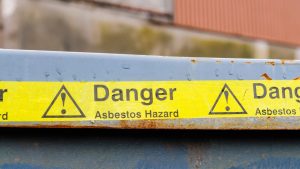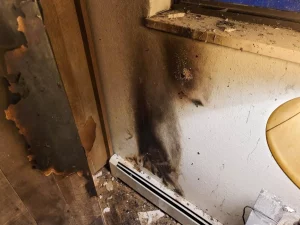Welcome to the RM Risk Management Blog
This is the area for all things RM news related

The Hidden Hazard: Asbestos Risks in Older UK Warehouses When Fire Strikes
What is Asbestos and Why Was it Used? Asbestos is a naturally occurring mineral that was once widely used in building insulation, roofing, pipe lagging, and fireproofing materials. In the mid-20th century, it was a staple of warehouse construction due to its low cost and impressive heat resistance. However, we now know that its fibres, when disturbed and inhaled, can cause serious and often fatal illnesses—including mesothelioma, asbestosis, and lung cancer. The Fire Risk: A Dangerous Trigger In warehouses where asbestos remains intact and undisturbed, the risk is minimal. But during a fire, asbestos-containing materials can crack, combust, or collapse—releasing clouds of microscopic fibres into the air. These fibres are invisible, virtually weightless, and can remain airborne for hours. Once dispersed, asbestos can pose risks far beyond the fire scene. Impact on Firefighters Firefighters are among the first to face the hazard. Despite using breathing apparatus, they can still be […]
Read More
Understanding Smoke Patterns After a Fire
1. Introduction Smoke patterns are a key component of post-fire analysis. They provide insight into the fire’s origin, development, and interaction with the surrounding environment. This report outlines the methods for identifying and interpreting smoke patterns to support accurate fire investigations. 2. Purpose of Analysing Smoke Patterns Smoke deposits help determine: – The origin point of the fire. – The direction and speed of fire spread. – The influence of ventilation, such as open windows or HVAC systems. – The presence of obstructions or removed items (through soot shadows). – Clues about accelerants or abnormal fire behaviour. 3. Factors Influencing Smoke Behaviour 3.1. Heat and Convection Currents Hot gases and smoke rise rapidly, forming V-patterns where flames impinge on vertical surfaces. The highest concentration of smoke residue typically aligns with the hottest path of travel. 3.2. Ventilation Openings (windows, doors, vents) affect how smoke flows. Smoke often moves […]
Read More
Should Landlords Take More Responsibility For Fire Safety in Multi Tenanted Buildings?
Since October 1, 2006, the Regulatory Reform (Fire Safety) Order 2005 has required the Responsible Person (RP) for any non-domestic premises to conduct a fire risk assessment. This assessment must include measures to reduce or eliminate fire risks and identify individuals at risk. If the RP does not have control over all parts of the building and shares it with others, they must inform those individuals about any significant risks identified. The person who does have control (such as the landlord, owner, or other employer) is responsible for ensuring compliance with the regulations in the areas they manage. This may necessitate communication and cooperation among all parties involved to coordinate fire safety provisions, firefighting measures, and evacuation procedures effectively. The Building Safety Act 2022 focuses on high-risk residential buildings but also applies to certain commercial premises that are at least 18 meters tall or have at least 7 […]
Read More
The Critical Importance of Fire Rated Glass in Building Design
What is Fire Rated Glass? Fire-rated glass, also known as fire-resistant safety glass, provides a protective barrier against smoke and flames in the event of a fire. The level of protection offered varies depending on the specific type of glass used. All fire-rated glass is designed to prevent the spread of flames and smoke throughout buildings during a fire. Unlike standard safety glass, which shares some high-strength properties, fire-rated glass undergoes rigorous testing to ensure that it can withstand the extreme temperatures encountered during a fire, providing effective protection for a specified duration. Designers and architects are increasingly incorporating fire-rated glass into their building designs. This choice allows them to maximise natural light and create open, connected interiors while ensuring the safety and well-being of occupants. Independent companies conduct fire resistance tests, and the official fire protection rating is based on strict parameters, including the size, frame, and installation […]
Read More
Key Risks Associated With Poor Fire Stopping
Poor fire stopping poses a significant risk of rapid fire spread within a building, potentially leading to substantial property damage, loss of life, and injuries to occupants due to the unchecked movement of flames and smoke through gaps and openings where fire stops should be installed properly; essentially, it can turn a contained fire into a much larger and more dangerous situation. Key risks associated with poor fire stopping Fire Spread: Without effective fire stops, flames and smoke can easily travel through walls, floors, and ceilings, rapidly spreading a fire throughout a building. Smoke Inhalation: Poor fire stopping can lead to a significant build-up of toxic smoke, posing a serious health threat to occupants trying to escape. Structural Damage: Uncontrolled fire spread can cause extensive structural damage to a building, potentially leading to collapse. Evacuation Challenges: Rapid fire spread can significantly impede escape routes, making it difficult for occupants to safely evacuate. […]
Read More
Understanding Notional, Nominal, and Upgraded Fire Doors: When to Upgrade
We are often asked to explain the differences between notional fire doors, nominal fire doors, and upgraded fire doors and how these differ from certified fire doors. There can be a lot of confusion surrounding fire doors, so we’ve compiled this short explanation. What are Nominal Fire Doors? A nominal fire door is typically made from timber and is designed to provide fire resistance for a specified duration. However, unlike certified fire doors, which have undergone rigorous performance testing to determine their fire rating, nominal fire doors rely solely on the opinion of a fire door inspector regarding their performance. An Explanation of Notional Fire Doors A notional fire door meets the fire resistance standards that were applicable at the time of its construction. However, these doors may not align with the latest codes, regulations, and tests. They may lack essential features such as intumescent strips and smoke seals, […]
Read More
Why Informing The Fire and Rescue Service about Asbestos Is Crucial
Asbestos management in commercial buildings like offices, warehouses, and industrial spaces is crucial. It’s essential to inform your local Fire and Rescue service about any asbestos materials present. This step ensures the safety of their staff and the surrounding community. Many Fire and Rescue services offer online portals for submitting this information, aligning with the Control of Asbestos Regulations 2012. These regulations mandate duty holders of non-domestic premises to provide details on the location and condition of asbestos or asbestos-containing materials to the emergency services. Prioritising this communication is key to maintaining a safe environment for all.
Read More
Understanding the Importance of Ventilation in Fire Safety
When a fire breaks out in a building, the flames are not the only danger to occupants—smoke inhalation is a leading cause of fatalities in fire-related incidents. Smoke contains toxic gases and particles that can reduce visibility, impede evacuation, and cause respiratory distress. This is where ventilation systems play a crucial role. Properly designed and well-maintained ventilation systems help control the movement of smoke, preventing its accumulation in escape routes and common areas. Instead, the smoke is redirected away from people, allowing a safer pathway to exit the building. Key Advantages of Effective Smoke Control through Ventilation Improved Escape Routes During a fire, unobstructed evacuation routes are essential. Efficient ventilation reduces smoke interference in escape paths, enabling occupants to exit quickly and safely. Improved Visibility Smoke-filled environments can disorient and induce panic, creating situations that may feel worse than they are. Effective ventilation reduces smoke concentration, enhancing visibility for […]
Read More
What Are Oxidising Materials?
Oxidising materials can significantly increase the intensity of fires, turning substances that generally do not burn readily into almost instant tinderboxes for chaos and destruction. The true danger of oxidising materials lies in their ability to create spontaneous combustion reactions that can occur without a clear ignition source. For those unfamiliar with chemistry, oxidising materials can have ambiguous origins and are often misidentified. It’s important to note that not all oxidisers can cause spontaneous ignition, and the severity of the resulting burn rate varies depending on their classification. Oxidising materials can exist as liquids, solids, or gases. The principal oxidising agents commonly found in commerce and industry are typically chemical compounds that contain significant amounts of oxygen. These include peroxides, superoxides, nitrates, chlorates, dichromates, permanganates, and persulfates. Inorganic oxidising agents are more frequently encountered in industrial applications than organic ones. […]
Read More
Are Fire Hydrants on Private Land often Forgotten?
A fire hydrant is a point where firefighters can access and connect to a water supply. It may be underground or a pillar type above ground. Fire hydrants (FH) are used to access water directly from the local mains supply to provide water for firefighting and are an important component of active firefighting. Therefore, fire hydrants must not be obstructed and must be kept in good working order. However, many fire hydrants found on private land, such as industrial estates, often go unmaintained, which could delay and seriously affect the operational requirements of the attending fire crews. Often, these can slip through the net when it comes to fire risk assessments (FRA). This is simply because the person carrying out the FRA may identify the site as having fire hydrants but assumes that these are either being maintained by the local Fire and Rescue Service or the landlord, as […]
Read More